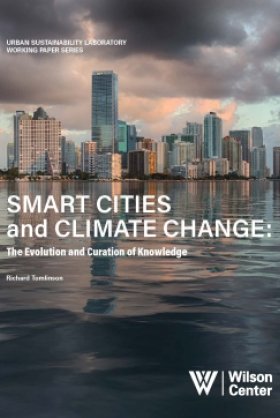Demography and Conflict: How Population Pressure and Youth Bulges Affect the Risk of Civil War
As populations grow larger, younger, and more urban, countries should develop adaptable resource management programs and bolster state and local political capacity to reduce the risk of civil conflict, says Henrik Urdal, a researcher at the International Peace Research Institute, Oslo.
Overview
As populations grow larger, younger, and more urban, countries should develop adaptable resource management programs and bolster state and local political capacity to reduce the risk of civil conflict, said Henrik Urdal, a researcher at the International Peace Research Institute, Oslo (PRIO) at a meeting sponsored by the Environmental Change and Security Program on March 5, 2007. Joined by Jennifer Dabbs Sciubba, doctoral candidate at the University of Maryland and a consultant for policy planning at the U.S. Department of Defense (DoD), Urdal discussed his recent research on the connection between population pressures and violent political conflict.
Population Growth and Resource Scarcity
Since the end of the Cold War, scholars have attempted to explain the underlying causes of conflict using a host of different variables, such as forced migration, ethnic and religious strife, inequality, and resource scarcity. According to the resource scarcity model, for example, rapid population growth is one of the major causes of scarcity of resources like fresh water and arable land, which then triggers armed conflict, particularly in developing countries.
Urdal's research does not support this theory across countries. But his new time-series study of India's 27 states finds a more significant relationship among population pressures, resource scarcity, and conflict within a country. The study, "Population, Resources and Political Violence: A Sub-National Study of India 1956-2002," examines political violence on the local level, where he believes the relationship between these variables is stronger. The evidence supporting an increased risk of conflict, according to Urdal, argues that programs aiming to reduce the risks target local contexts.
 Another theory suggests that conflict will be spurred by rapid urbanization, which is already underway: over the next decade, more than 200 million people are expected to move from rural to urban areas. But Scuibba pointed out that the evidence does not support the claim: "It seems very logical that young people who lack opportunities would fight over scant resources, but a lot of the research actually points to the fact that this may not be the case." Urdal's research shows that rapid population growth and increased population density are not significant factors in the onset of conflict. In fact, he said, "In the post-Cold War period, countries with the highest urbanization rates experience lower risk of conflict."
Another theory suggests that conflict will be spurred by rapid urbanization, which is already underway: over the next decade, more than 200 million people are expected to move from rural to urban areas. But Scuibba pointed out that the evidence does not support the claim: "It seems very logical that young people who lack opportunities would fight over scant resources, but a lot of the research actually points to the fact that this may not be the case." Urdal's research shows that rapid population growth and increased population density are not significant factors in the onset of conflict. In fact, he said, "In the post-Cold War period, countries with the highest urbanization rates experience lower risk of conflict."
Youth Bulge
Developing countries bear the brunt of rapid population growth, and are currently facing the largest ever youth cohort in history—1.3 billion people between the ages of 12 and 24. New research reveals that countries with particularly young age structures—known as "youth bulges"—may be more prone to conflict. "In countries where youth make up 35 percent of the total adult population," said Urdal, "the risk of conflict, with all other factors being equal, increases by 150 percent" compared to countries where youth make up only 17 percent of the adult population, as in most developed countries. In 2000, youth made up 35 percent or more of the adult population in 44 countries, including many in sub-Saharan Africa, the Middle East, and South Asia. According to Sciubba, this data helps the DOD identify countries that may be on the brink of conflict.
Contextual factors, such as stability within the economy and the labor market, can be critical to understanding the relationship between youth bulges and conflict. Urdal's research found that economic instability, such as a recession, interacts with larger youth bulges to produce a greater risk of terrorist events: "In poorer countries, where the opportunity costs of youth are particularly low, failure to facilitate an integration of youth into the labor market may actually increase the risk of political violence." He also noted that youth bulges can become a particular problem when countries expand higher education without securing employment opportunities for youth: "[A]fter large expansions in tertiary education, youth bulges seem to have an increasing impact on risk for terrorism events."
Parsing Policy From Population Data
According to Sciubba, the combined findings from Urdal's cross-national and sub-national studies suggest that demography is not destiny. This is good news, she said, noting that the DOD can do little about factors like rapid population growth. Instead, data from studies such as Urdal's reveal that the United States can help reduce the risk of conflict by reinforcing good governance and building political capacity: "I think those are traits that [the] U.S. foreign policy community can positively impact [in] other countries."
Drafted by Sean Peoples.
Documents & Downloads
- Demography and Conflict: How Population Pressure and Youth Bulges Affect the Risk of Civil WarDownload
- Demography and Conflict: How Population Pressure and Youth Bulges Affect the Risk of Civil WarDownload
- Demography and Conflict: How Population Pressure and Youth Bulges Affect the Risk of Civil WarDownload
Speakers
Hosted By

Environmental Change and Security Program
The Environmental Change and Security Program (ECSP) explores the connections between environmental change, health, and population dynamics and their links to conflict, human insecurity, and foreign policy. Read more
Thank you for your interest in this event. Please send any feedback or questions to our Events staff.










